Sensitivity Analysis on Influential Factors of Strain Rockburst in Deep Tunnel
Abstract
1. Introduction
2. A Numerical Analysis Method for Rockburst Considering the Full Stress State Energy
2.1. BBM-3DEC Coupled Numerical Simulation Method for Rockburst Based on Energy Principle
2.2. Application and Validation of the Proposed Numerical Simulation Method
2.2.1. Application and Validation at Test Scale
2.2.2. Application and Validation at Engineering Scale
3. Numerical Model for Strain Rockburst and Simulation Program
3.1. Numerical Model and Boundary Conditions
3.2. Mechanical Parameters of the Model
4. Influencing Controlling Factors of Strain Rockburst in Deep Tunnel
4.1. Influence of Compressive Strength
4.2. Influence of Tensile Strength
4.3. Influence of Tunnel Depth
4.4. Influence of Lateral Pressure Coefficient
5. Sensitivity Analysis of Controlling Factors for Strain Rockburst in Deep Tunnel
5.1. Rockburst Tendency under Different Influential Factors
5.2. Sensitivity Analysis of Influential Factors Based on Rockburst Tendency
6. Conclusions
Author Contributions
Funding
Data Availability Statement
Acknowledgments
Conflicts of Interest
References
- Cui, J.; Broere, W.; Lin, D. Underground space utilisation for urban renewal. Tunn. Undergr. Space Technol. 2021, 108, 103726. [Google Scholar] [CrossRef]
- Liu, X.; Wang, G.; Song, L.; Han, G.; Chen, W.; Chen, H. A new rockburst criterion of stress–strength ratio considering stress distribution of surrounding rock. Bull. Eng. Geol. Environ. 2023, 82, 29. [Google Scholar] [CrossRef]
- Niu, W.; Feng, X.; Yao, Z.; Bi, X.; Yang, C.; Hu, L.; Zhang, W. Types and occurrence time of rockbursts in tunnel affected by geological conditions and drilling & blasting procedures. Eng. Geol. 2022, 303, 106671. [Google Scholar]
- Li, P.; Zhao, J.; Bu, W.; Niu, W.; Liu, P.; Sun, M. Optimization of Rockburst Risk Control Measures for Deeply Buried TBM Tunnels: A Case Study. Buildings 2023, 13, 1440. [Google Scholar] [CrossRef]
- Zhang, Q.; Zhang, X.; Liu, Q.; Qiu, J.; Wu, J. Rockburst prediction and prevention in a deep-buried tunnel excavated by drilling and blasting: A case study. Eng. Geol. 2024, 330, 107404. [Google Scholar] [CrossRef]
- Guo, J.; Zhu, Z.; Zhang, H.; Sun, F.; He, B. Study on Catastrophe Information Characteristics of Strain-Structural Plane Slip Rockburst in Deep Tunnels. Appl. Sci. 2023, 13, 12396. [Google Scholar] [CrossRef]
- Zhang, D.; Sun, Z.; Fang, Q. Scientific problems and research proposals for Sichuan-Tibet railway tunnel construction. Undergr. Space 2022, 7, 419–439. [Google Scholar] [CrossRef]
- Feng, G.; Ma, J.; Chen, B.; Xiao, Y.; Jiang, Q.; Li, P.; Lin, M. Microseismic energy and intensity criterion of rockburst in deep TBM tunnels: A case study of the Neelum-Jhelum hydropower project. J. Cent. South Univ. 2023, 30, 1695–1709. [Google Scholar] [CrossRef]
- Zhang, S.; Ma, T.; Tang, C.; Jia, P.; Wang, Y. Microseismic Monitoring and Experimental Study on Mechanism of Delayed Rockburst in Deep-Buried Tunnels. Rock Mech. Rock Eng. 2020, 53, 2771–2788. [Google Scholar] [CrossRef]
- Liu, X.; Zhang, S.; Wang, E.; Zhang, Z.; Wang, Y.; Yang, S. Multi-Index Geophysical Monitoring and Early Warning for Rockburst in Coalmine: A Case Study. Int. J. Environ. Res. Public Health 2023, 20, 392. [Google Scholar] [CrossRef]
- Eremenko, A.A.; Mulev, S.N.; Shtirts, V.A. Microseismic Monitoring of Geodynamic Phenomena in Rockburst-Hazardous Mining Conditions. J. Min. Sci. 2022, 58, 10–19. [Google Scholar] [CrossRef]
- Zhang, C.; Feng, X.; Zhou, H.; Qiu, S.; Wu, W. Case Histories of Four Extremely Intense Rockbursts in Deep Tunnels. Rock Mech. Rock Eng. 2012, 45, 275–288. [Google Scholar] [CrossRef]
- Su, G.; Shi, Y.; Feng, X.; Jiang, K.; Zhang, J.; Jiang, Q. True-Triaxial Experimental Study of the Evolutionary Features of the Acoustic Emissions and Sounds of Rockburst Processes. Rock Mech. Rock Eng. 2018, 51, 375–389. [Google Scholar] [CrossRef]
- Su, G.; Jiang, J.; Feng, X.; Jiang, Q.; Chen, Z.; Mo, J. Influence of loading rate on strainburst: An experimental study. Bull. Eng. Geol. Environ. 2019, 78, 3559–3573. [Google Scholar] [CrossRef]
- He, M.; Ren, F.; Liu, D.; Zhang, S. Experimental Study on Strain Burst Characteristics of Sandstone Under True Triaxial Loading and Double Faces Unloading in One Direction. Rock Mech. Rock Eng. 2021, 54, 149–171. [Google Scholar] [CrossRef]
- Zhou, J.; Zhang, Y.; Li, C.; He, H.; Li, X. Rockburst prediction and prevention in underground space excavation. Undergr. Space 2024, 14, 70–98. [Google Scholar] [CrossRef]
- Luo, C.; Zhang, S.; Tang, B.; Chen, J.; Yin, C.; Li, H. Research on Stress Characteristics of Rockburst in Over-Length Deep-Buried Tunnel. Buildings 2024, 14, 2298. [Google Scholar] [CrossRef]
- He, M.; Cheng, T.; Qiao, Y.; Li, H. A review of rockburst: Experiments, theories, and simulations. J. Rock Mech. Geotech. 2023, 15, 1312–1353. [Google Scholar] [CrossRef]
- Liu, G.; Meng, H.; Song, G.; Bo, W.; Zhao, P.; Ning, B.; Xu, X. Numerical simulation of wedge failure of rock slopes using three-dimensional discontinuous deformation analysis. Environ. Earth Sci. 2024, 83, 310. [Google Scholar] [CrossRef]
- Sun, F.; Guo, J.; Liu, X.; Zhang, H. Strain rockburst evolution process under true triaxial condition with single face unloading due to tunnel excavation. Comput. Geotech. 2023, 159, 105465. [Google Scholar] [CrossRef]
- Xue, Y.; Cao, Z.; Li, Z. Destabilization mechanism and energy evolution of coal pillar in rockburst disaster. Arab. J. Geosci. 2020, 13, 557. [Google Scholar] [CrossRef]
- Hu, L.; Ma, K.; Liang, X.; Tang, C.; Wang, Z.; Yan, L. Experimental and numerical study on rockburst triggered by tangential weak cyclic dynamic disturbance under true triaxial conditions. Tunn. Undergr. Space Technol. 2018, 81, 602–618. [Google Scholar] [CrossRef]
- Yang, F.; Hui, Z.; Xiao, H.; Azhar, M.U.; Yong, Z.; Chi, F. Numerical simulation method for the process of rockburst. Eng. Geol. 2022, 306, 106760. [Google Scholar]
- Kong, P.; Wang, C.; Xing, L.; Liang, M.; He, J. Study on the fault slip rule and the rockburst mechanism induced by mining the panel through fault. Geomech. Geophys. Geo-Energy Geo-Resour. 2023, 9, 163. [Google Scholar] [CrossRef]
- Ma, K.; Peng, Y.; Liao, Z.; Wang, Z. Dynamic responses and failure characteristics of the tunnel caused by rockburst: An entire process modelling from incubation to occurrence phases. Comput. Geotech. 2024, 171, 106340. [Google Scholar] [CrossRef]
- Gao, H.; Xie, H.; Zhang, Z.; Lu, J.; Zhang, D.; Zhang, R.; Wu, M. True triaxial energy evolution characteristics and failure mechanism of deep rock subjected to mining-induced stress. Int. J. Rock Mech. Min. 2024, 176, 105724. [Google Scholar] [CrossRef]
- Zhu, B.; Fan, J.; Shi, X.; Liu, P.; Guo, J. Study on Rockburst Proneness of Deep Tunnel Under Different Geo-Stress Conditions Based on DEM. Geotech. Geol. Eng. 2022, 40, 1373–1386. [Google Scholar] [CrossRef]
- Chen, W.; Lv, S.; Guo, X.; Qiao, C. Research on unloading confining pressure tests and rockburst criterion based on energy theory. Chin. J. Rock Mech. Eng. 2009, 28, 1530–1540. [Google Scholar] [CrossRef]
- Jiang, B.Y.; Wang, L.G.; Gu, S.T.; Zhang, X.D.; Li, W.S. Study on rockburst mechanism of TBM excavation for deep tunnel based on energy principle. J. Min. Saf. Eng. 2017, 34, 1103–1109+1115. [Google Scholar] [CrossRef]
- GB50218-2014; Standard for Engineering Classification of Rock Mass. The Standardization Administration of the People’s Republic of China: Beijing, China, 2014.
- Wang, Q.; Ju, N.; Du, L.; Huang, J.; Jiang, J. Inverse Analysis of Geostress Field in Bayu Deep-buried Tunnel on Lhasa–Linzhi Railway. Rail. Eng. 2016, 10, 59–62. [Google Scholar] [CrossRef]
- Zhu, Z.; Sun, F.; Guo, J. Study on rockburst tendency of deep underground engineering based on multi-factor influence. Electron. J. Struct. Eng. 2023, 23, 1–12. [Google Scholar] [CrossRef]
- Yang, B.; He, M.; Zhang, Z.; Zhu, J.; Chen, Y. A New Criterion of Strain Rockburst in Consideration of the Plastic Zone of Tunnel Surrounding Rock. Rock Mech. Rock Eng. 2023, 159, 105465. [Google Scholar] [CrossRef]
- Yang, J.; Yang, X.; Zhou, J.; Liu, Y.; Dong, B.; Li, H. Comparative Study of the Excavation Damage and Rockburst of the Deeply Buried Jinping II Diversion Tunnels Using a TBM and the Drilling-Blasting Method. Adv. Civ. Eng. 2020, 2020, 8876214. [Google Scholar] [CrossRef]
- Si, X.; Peng, K.; Luo, S. Experimental Investigation on the Influence of Depth on Rockburst Characteristics in Circular Tunnels. Sensors 2022, 22, 3679. [Google Scholar] [CrossRef] [PubMed]
- Tosun, N. Determination of optimum parameters for multi-performance characteristics in drilling by using grey relational analysis. Int. J. Adv. Manuf. Technol. 2006, 28, 450–455. [Google Scholar] [CrossRef]
- Xie, H.; Yu, T.; Lin, P.; Wang, Z.; Xu, Z. Effect of petrographic characteristics on uniaxial compressive strength of granitic rocks from Xinjiang, China. J. Cent. South Univ. 2023, 30, 2340–2359. [Google Scholar] [CrossRef]
- Hu, X.; Su, G.; Li, Z.; Xu, C.; Yan, X.; Liu, Y.; Yan, L. Suppressing rockburst by increasing the tensile strength of rock surface: An experimental study. Tunn. Undergr. Space Technol. 2021, 107, 103645. [Google Scholar] [CrossRef]

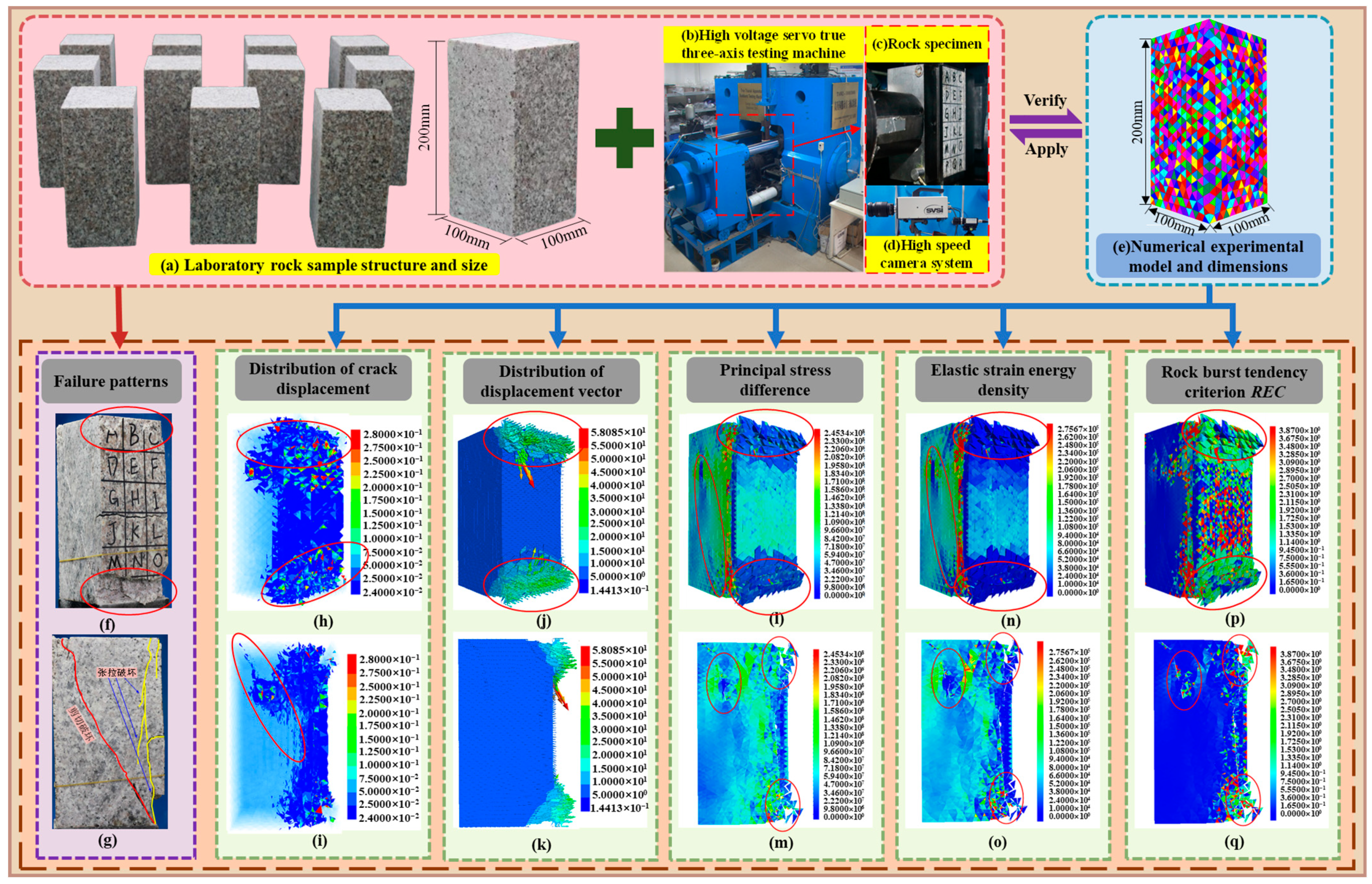

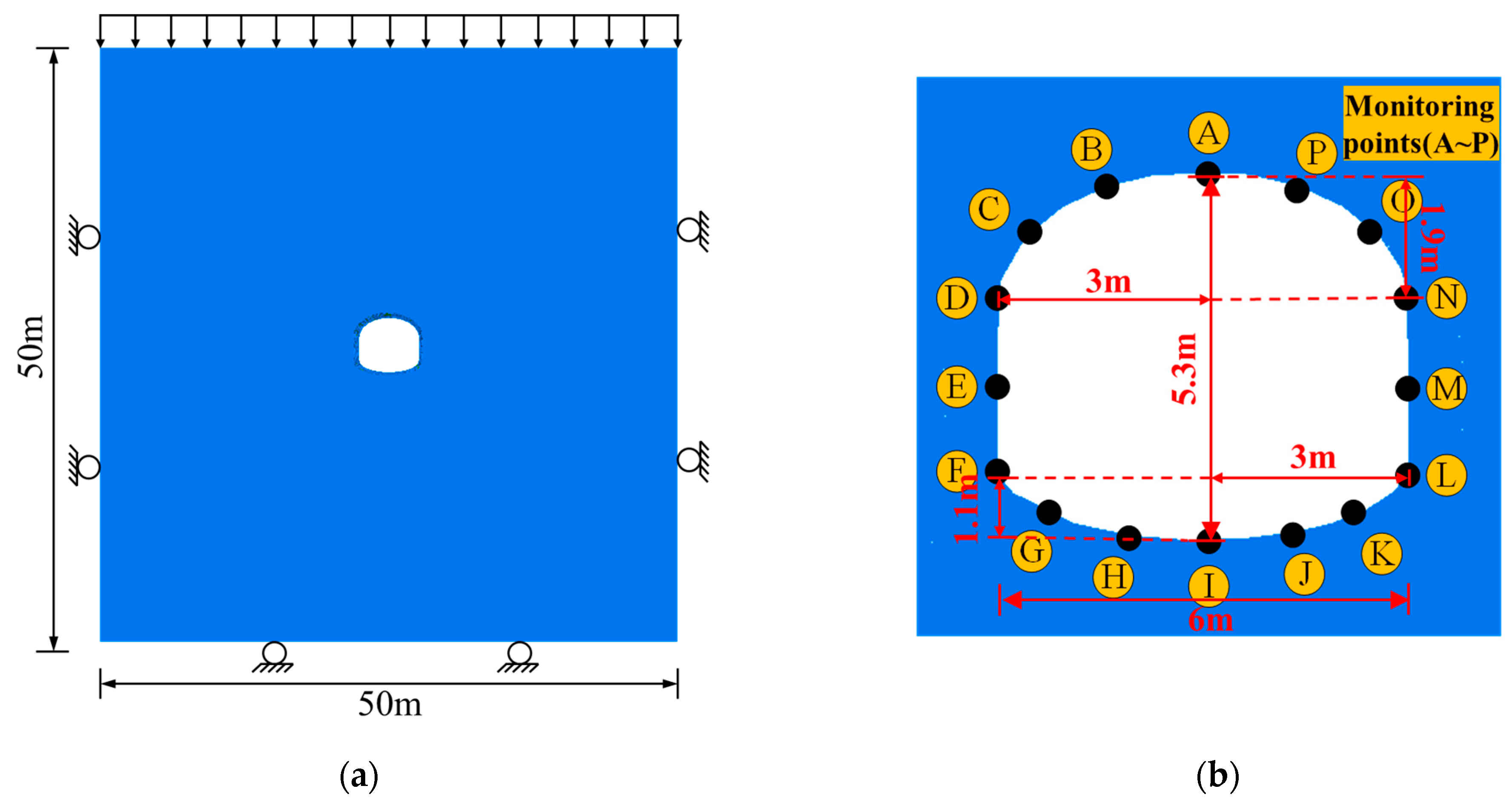
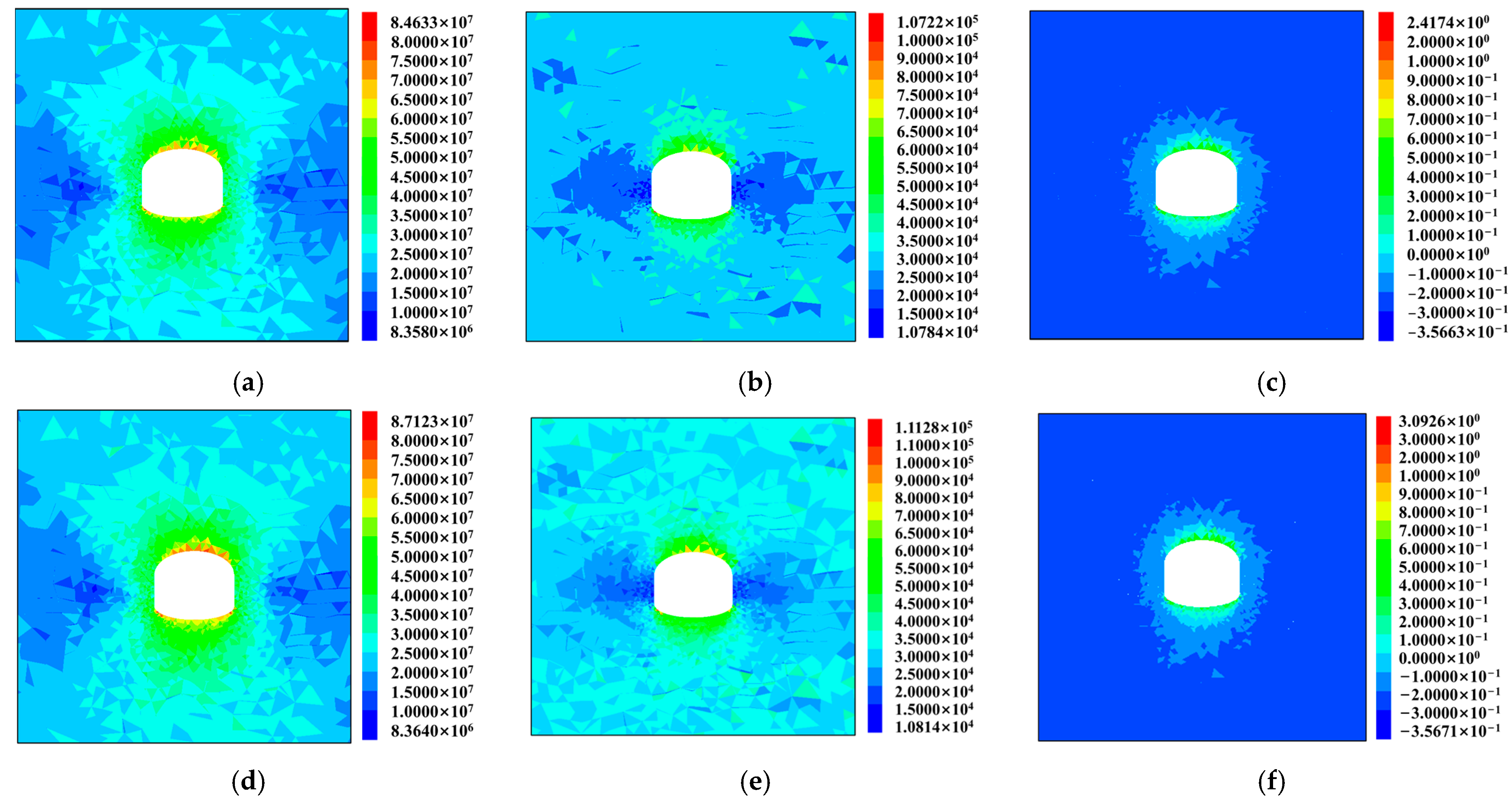


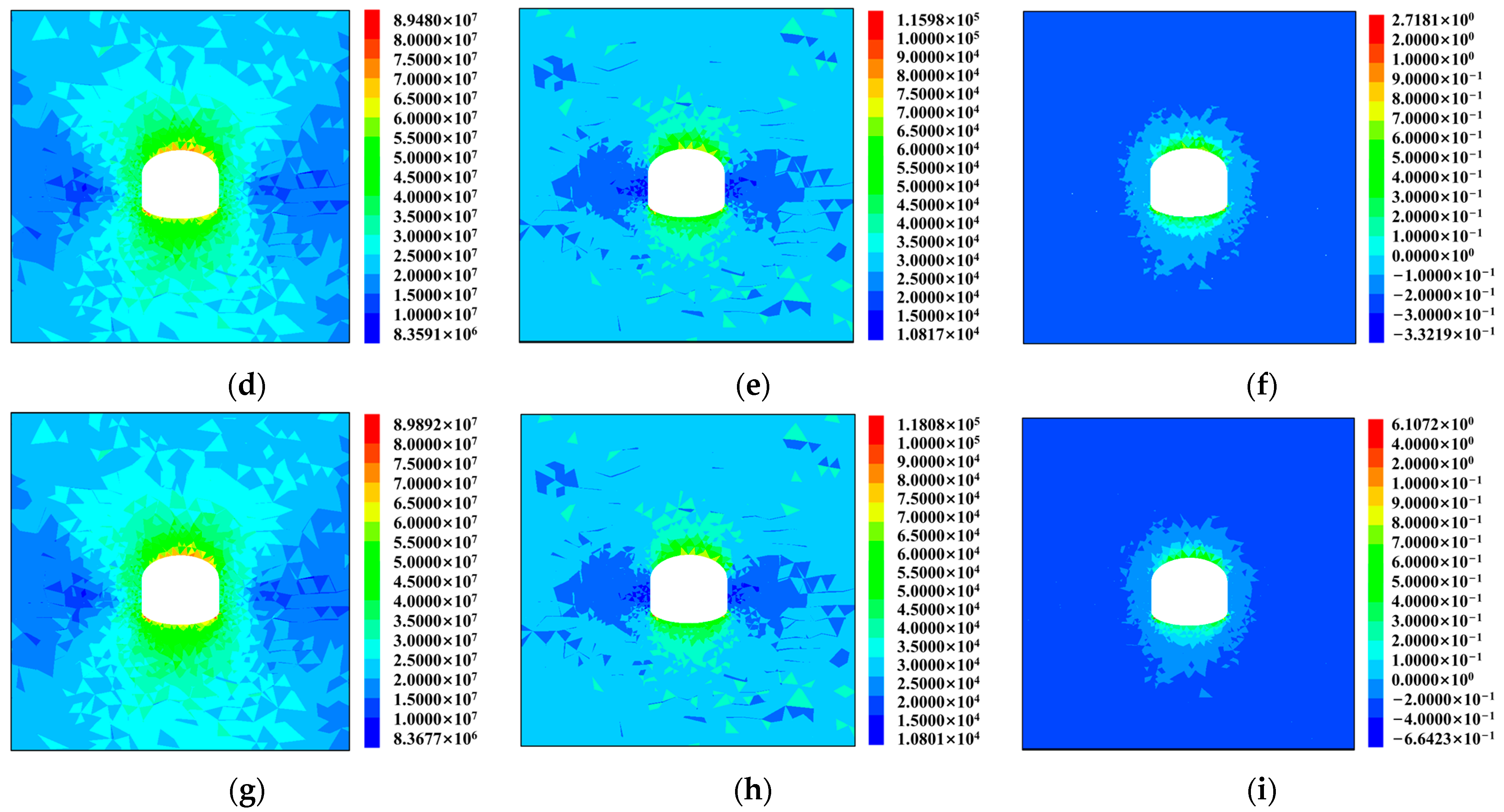

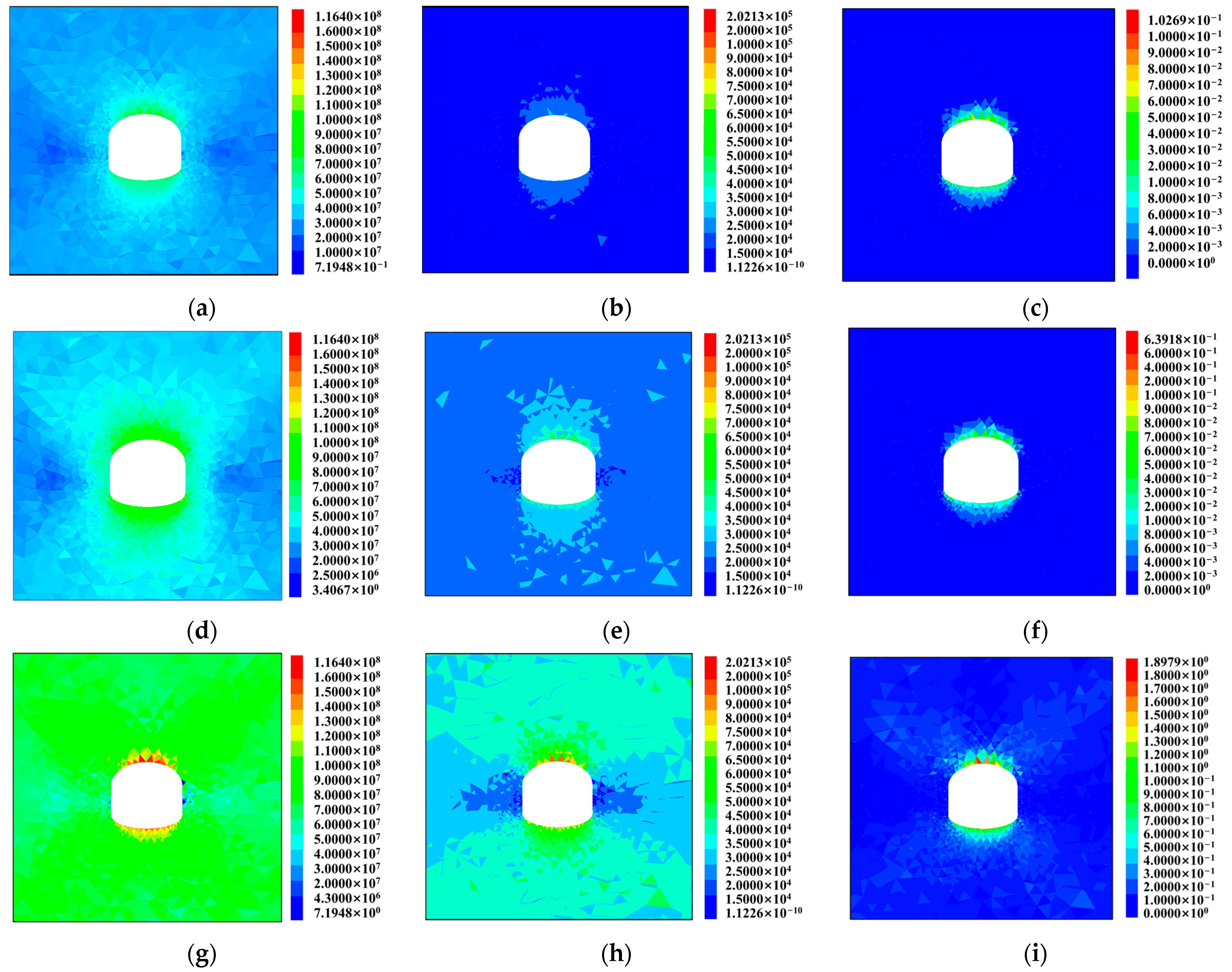

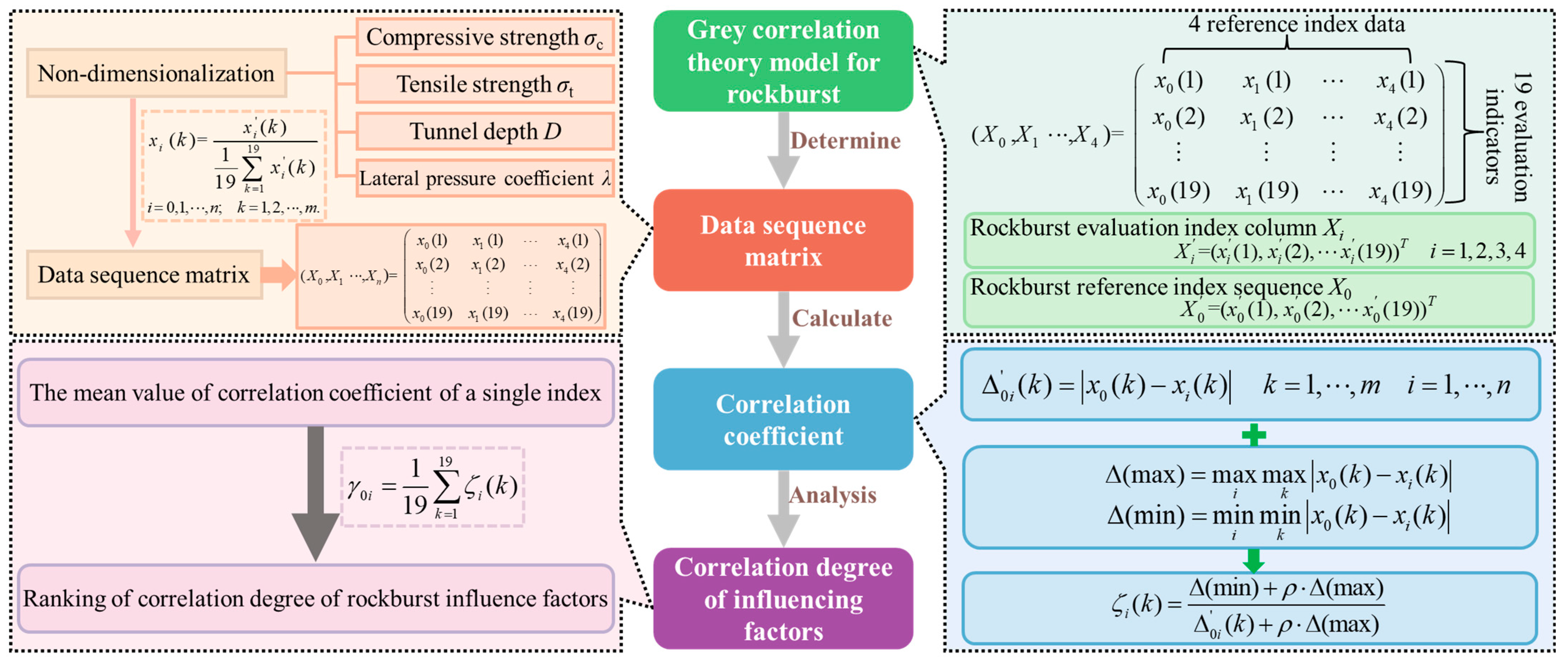
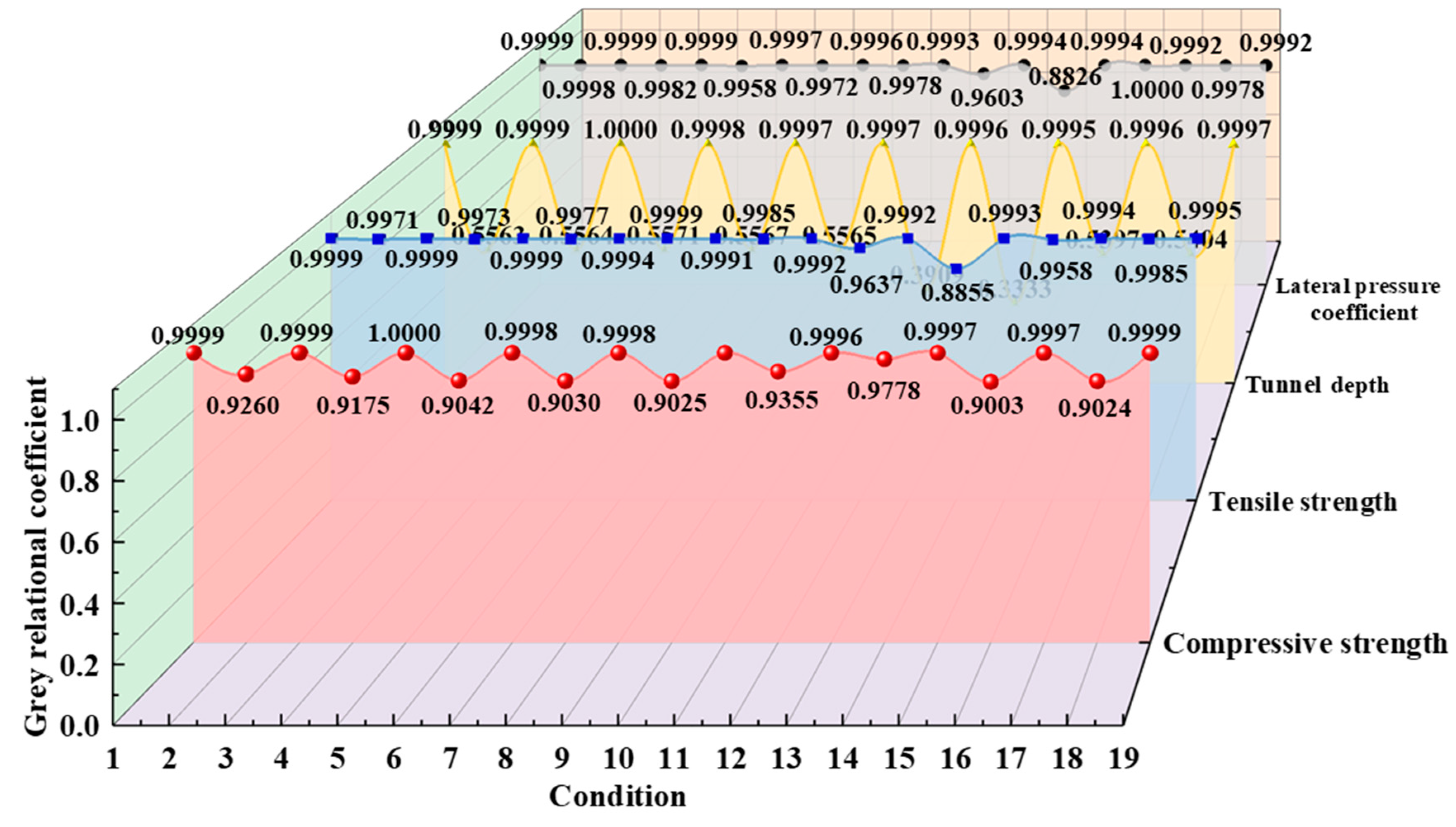

| Rock Type | Elastic Modulus (GPa) | Poisson’s Ratio | Density (kg/m3) | Cohesive Force (MPa) | Internal Friction Angle (°) | Compressive Strength (MPa) | Tensile Strength (MPa) |
|---|---|---|---|---|---|---|---|
| Diorite | 36 | 0.20 | 2600 | 2.3 | 45 | 143.78 | 7.04 |
| Volumetric Weight (kN/m3) | Elastic Modulus (GPa) | Bulk Modulus (GPa) | Shear Modulus (GPa) | Internal Friction Angle (°) | Cohesion Force (MPa) | Tensile Strength (MPa) |
|---|---|---|---|---|---|---|
| 28.48 | 33.60 | 20.74 | 13.66 | 52.51 | 23.75 | 7.45 |
| Parameter | Normal Stiffness (GPa/m) | Shear Stiffness (GPa/m) | Internal Friction Angle (°) | Cohesion Force (MPa) |
|---|---|---|---|---|
| Virtual joint | 70.45 | 52.20 | 53.51 | 26.67 |
| Condition | Compressive Strength σc (MPa) | Tensile Strength σt (MPa) | Tunnel Depth D (m) | Lateral Pressure Coefficient λ |
|---|---|---|---|---|
| 1 | 60 | 7.45 | 1000 | 1.5 |
| 2 | 70 | 7.45 | 1000 | 1.5 |
| 3 | 80 | 7.45 | 1000 | 1.5 |
| 4 | 90 | 7.45 | 1000 | 1.5 |
| 5 | 100 | 7.45 | 1000 | 1.5 |
| 6 | 120 | 4 | 1000 | 1.5 |
| 7 | 120 | 6 | 1000 | 1.5 |
| 8 | 120 | 8 | 1000 | 1.5 |
| 9 | 120 | 10 | 1000 | 1.5 |
| 10 | 120 | 12 | 1000 | 1.5 |
| 11 | 100 | 8 | 500 | 1.5 |
| 12 | 100 | 8 | 1000 | 1.5 |
| 13 | 100 | 8 | 1500 | 1.5 |
| 14 | 100 | 8 | 2000 | 1.5 |
| 15 | 100 | 8 | 2500 | 1.5 |
| 16 | 100 | 8 | 1000 | 0.9 |
| 17 | 100 | 8 | 1000 | 1.2 |
| 18 | 100 | 8 | 1000 | 1.8 |
| 19 | 100 | 8 | 1000 | 2.1 |
Disclaimer/Publisher’s Note: The statements, opinions and data contained in all publications are solely those of the individual author(s) and contributor(s) and not of MDPI and/or the editor(s). MDPI and/or the editor(s) disclaim responsibility for any injury to people or property resulting from any ideas, methods, instructions or products referred to in the content. |
© 2024 by the authors. Licensee MDPI, Basel, Switzerland. This article is an open access article distributed under the terms and conditions of the Creative Commons Attribution (CC BY) license (https://creativecommons.org/licenses/by/4.0/).
Share and Cite
Gu, J.; Guo, J.; Zhu, Z.; Sun, F.; He, B.; Zhang, H. Sensitivity Analysis on Influential Factors of Strain Rockburst in Deep Tunnel. Buildings 2024, 14, 2886. https://doi.org/10.3390/buildings14092886
Gu J, Guo J, Zhu Z, Sun F, He B, Zhang H. Sensitivity Analysis on Influential Factors of Strain Rockburst in Deep Tunnel. Buildings. 2024; 14(9):2886. https://doi.org/10.3390/buildings14092886
Chicago/Turabian StyleGu, Jiheng, Jiaqi Guo, Zihui Zhu, Feiyue Sun, Benguo He, and Hengyuan Zhang. 2024. "Sensitivity Analysis on Influential Factors of Strain Rockburst in Deep Tunnel" Buildings 14, no. 9: 2886. https://doi.org/10.3390/buildings14092886
APA StyleGu, J., Guo, J., Zhu, Z., Sun, F., He, B., & Zhang, H. (2024). Sensitivity Analysis on Influential Factors of Strain Rockburst in Deep Tunnel. Buildings, 14(9), 2886. https://doi.org/10.3390/buildings14092886






